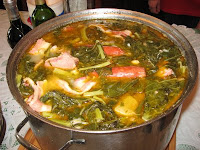
Last Sunday we visited Grace and Roberto again - a couple of months ago we learned how to make Grace’s delicious Carne con Papas – but this time Roberto taught us how to make his famous Caldo Gallego. OH. MY. GOD! It is so good , particularly when it’s a little cold outside as it was on Super Bowl Sunday.
Here's Roberto - our teacher for the day.

Caldo Gallego is a traditional Cuban dish with origins in Galicia, Spain. It is comfort food for many because it’s so warm and hearty. You can serve Caldo Gallego in a small bowl as a soup course, but most often it is served in a big bowl as the main meal because it contain greens, beans and meat. Don’t let the amount of fat used fool you, the beans and collard greens make it a relatively healthy meal.
Since it takes a long time to make, it is best to make large quantities and freeze the remainders – it gets better with time. And again, because it takes quite a while and requires some prep work – lots of peeling and cutting – do what we did and get together with a few friends. Be sure the wine is good and plentiful and that you have some “saladitos” for sustenance during the hard work – we had ham and manchego cheese canapés along with fresh fruit.
 Ingredients:
Ingredients:8 quarts of water
3 lbs dried Great Northern Beans
5 lbs potatoes – peeled and chunked
3 lbs turnips – peeled and chunked
4 lbs flank steak – cut into large pieces
5 lbs bone-in-ham – cut into large pieces
2 lbs bacon slices (sliced bacon slab or pancetta can also be used)
6 oz. salt pork (or pork leaf fat called “unto” in Spanish) – rinsed and cut up
10 Spanish chorizos
2 bunches of collard greens – washed well and shredded
- NOTE: This is what the "unto" or salt pork/pork leaf fat looks like in the package.

Process
This recipe makes approximately 20 servings.
- Soak the beans between 6 and 8 hours.
- Peel and chunk potatoes and turnips.
- Cut the flank steak and the ham – save the ham bone.
- Add all the ingredients, including the ham bone – except the collard greens - to the beans and water.
- Bring to a boil - it doesn't look pretty, but it's OK - it'll get better.
- Set temperature to medium and cook until the beans are ready - approximately 90 minutes.
- NOTE: At this point the broth will be a reddish-orange because of the chorizo. Don’t panic! It will change color once the greens are added.
- Wash, shred and add the collard greens.
- Cook for an additional 30 minutes.
- Remove the flank steak pieces, the ham pieces, the chorizo and the ham-bone and serve on a separate platter.




The finished product!

Serve with crusty bread - preferably Cuban - and a hearty Rioja wine.
¡Buen provecho!








10 comments:
sounds delish...i'm wondering how to adapt it for a slow cooker?
Karoda -
I'm glad you liked the recipe - it's perfect for winter. As to making it in a slow cooker, it would definitely reduce the soaking time on the beans, but I don't know how long you could keep the veggies, meat and greens in there before they fall apart. Maybe Google "crockpot caldo gallego" and use their times but our ingredients.
Let us know if it works out....:)
On the collard greens, did he just use the leaves or did he use the stalks also? I've heard you don't use the stalks when cooking collard greens. Thanks and keep up the good work.
Anon...
He actually used the sytalks and they became tender - but stalks are definitely optional.
Enjoy!
Looking forward to next posts or posts of future recipes to come :)
Maybe a recipe for "Masitas de Puerco" or a Cuban recipe feauturing duck (I know some Cubans use to cook duck wayyyy back but it wasn't popular) or something really old skool like "Carne de Puerco Con Quimbombo" (I'm not satisfied with my recipe maybe someone you know makes an awesome one) or how bout a pictorial on making lechon (I got the marinade and seasoning down but I mess up on the cooking I never get that wonderful crackling skin and I tend to somewhat dry it out)
Hmmmmm.... Frituritas are nice how bout some "Frituritas de Bacalao"? I'd be interested in seeing how others make it.
Or some seafood recipe's like maybe a Cuban style "Zarzuela"? or Empanada recipe?
Oooh I just thought of something else how bout for the upcoming hot weather some "Escabeche" (with sword fish, shark or red snapper filets, etc.?I'd like to see a Cuban recipe for it I only know the Spaniard preparation for this stuff and it's with sardines)
gallego means galicia this is not a cuban dish at all but enjoyed and cooked by them as anybody can cook this around the world. but its orgins and name speaks for itself galicia spain.
Anonymous: Make no mistake, this IS a Cuban recipe; made in every Cuban household for many decades. My Cuban grandmother (born in 1898) learned how to make it from her mother, also Cuban. I'm sure it has Spanish roots, since Spain is the motherland. Nonetheless, this IS a traditional Cuban dish.
It is also a traditional soup in Puerto Rico. Many of my relatives immigrated from the Galician area of Spain to Puerto Rico in the mid 19th century, and they brought with them a love of Caldo Gallego. This soup is also enjoyed elsewhere on the Iberian peninsula, with a delicious Portuguese version made with linguica sausage.
The version I always enjoyed as a child was simple and flavorful: kale, chick peas, salt pork and ham for flavoring, lots of garlic and chorizo. No beef.
Yes, it's *from* Galicia, as was explained in the introduction. If you know anything about the significant Galcian (as well as other Spanish regions) influence on Cuban cooking, you wouldn't be so shocked at the inclusion of Caldo Gallego in this blog.
As the name of this Blog states, these are *Cuban* home-style recipes. As is stated in the recipe, this is indeed a Spanish - specifically Galician - dish. However, it is one of the many Cuban interpretations of the dish - every cook adds his or her own touch to make it theirs.
It's all good. ¡Buen provecho!
Post a Comment